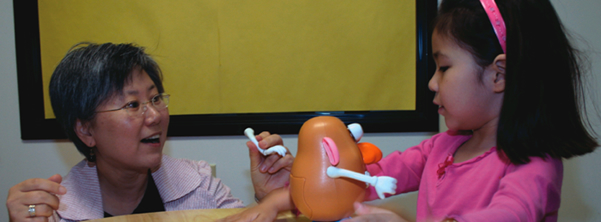Developing Communication
HyeKyeung Seung is improving the language skills of children with autism
October 29, 2007
By Valerie Orleans
Children with autism find social interaction a challenge; for the 50 percent of those who are non-verbal, that challenge seems insurmountable.
HyeKyeung Seung should know. As associate professor of human communication studies, Seung’s research focuses on helping those children and their parents to communicate. Presently, she is working on language development with children who speak 50 words or less.
“I see these children three times a week,” she said. “I work on teaching them vocal sounds through play.”
Starting with simple sounds — “ma,” “mu” and “me” — Seung tries to teach children that simple consonant and vowel sounds can be translated into words — “ba” for ball, “bu” for bubbles and so on.
“It’s very labor intensive,” said Seung, who is assisted by undergraduate students and the children’s parents. “We videotape the sessions to show progress. We also train parents so they can continue the exercises at home.”
So far, parents report that the participating children are vocalizing more or attempting to make sounds.
“Some reports indicate that about 50 percent of autistic children are non-verbal,” Seung explains. “Autism is a spectrum disorder, meaning that individuals function at different levels. Some with autism are brilliant while others are almost incapacitated. Everyone with autism experience problems with social skills, and inappropriate behaviour -- talking loudly in church, at the movies or in other public settings, or speaking in monotones. Because they aren’t attuned to people or their social settings, they often lag behind their age group in acquiring speaking, comprehension and other skills.
Seung also is developing a support group for Korean American parents of autistic children. Supported by a grant from the Yen Do scholarship fund in the College of Communications, Seung held her first meeting in June.
“The women whose children I was working with asked me to start a group.” she said. There is a large Korean population in Fullerton, Seung explained, and “there is so much erroneous information out on the web.”
“Well-educated parents are quick to research different interventions and treatments,” she said. “But, like many things on the web, the studies found there are not always evidence-based.”
The group meets monthly and Seung said she hopes to start a group for Vietnamese American parents soon.
In another study, Seung is working with higher functioning autistic children on the relationship between the role of language and “theory of mind,” in conjunction with Hyeonjin Lee, a colleague from YoungNam University in Korea.
“Even though we can’t see what others think, a ‘theory of mind’ approach allows us to infer their meaning based on their beliefs, desires and emotions,” Seung said. “Autistic children are socially naïve. They often behave inappropriately and are teased by their peers. They don’t perceive the subtleties of communication.”
The researchers tease out language skills by showing the children drawings and asking them to interpret. For example, one set of cards shows children with a sandcastle, children with a ball, and children pushing a ball. The researcher takes the cards away and asks: “What was the boy pushing?”
They are also focusing on the differences between Korean speakers and English speakers.
“We’re trying to see if there are any linguistic differences for children with autism who speak different languages,” she said, adding that she and Lee will present their results at a conference in Korea next year.

